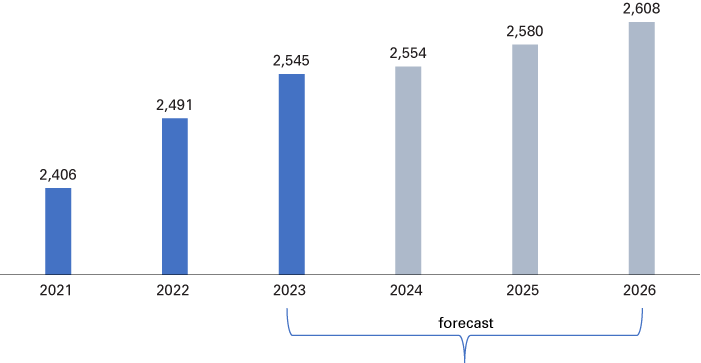
Indiana’s outlook for 2024

Director and Executive Editor, Indiana Business Research Center, Indiana University Kelley School of Business
Our forecast for Indiana was split last year: We were either going to have a short recession or very slow growth. As it turned out, nationwide economic growth this year was slow, but not negative, during the first half of the year. Then, boom – GDP grew by nearly 5% between the second and third quarters. Since then, we’ve been hearing some economists’ cries of “it’s a flash in the pan” and “we’re gonna crash out in the fourth” or even “we told you so” (please send this author the name of that economist, since most were darn sure we’d have a recession). It’s a bit like watching football, including the Monday morning quarterbacking.
We’re not going to wait for the end of this article to tell you what our Center for Econometric Model Research (CEMR) forecasts for Indiana across key measures of our economy. Our forecast calls for Indiana to manage small gains in net growth across most measures: Indiana's GDP in 2024 will grow at quarterly rates of less than 1% throughout the year, picking up some steam in 2025, with quarterly rates between 1% and 2% per quarter. There will be steady but small gains in output for durable goods in 2024, but 2.1% gains in the first quarter and 1.9% gains in the third quarter won't compensate for the quarterly nondurable manufacturing losses in output ranging from 2.5% to 2.8%.
Indiana's resident labor force will inch closer to a significant milestone of 3.5 million persons either actively employed or actively seeking work (see Figure 3). The unemployment rate will track steadily below 5% and often below 4%. Indiana businesses will total 3.3 million jobs -- most of which will employ Hoosiers, but don't forget folks drive in from surrounding states to work. We forecast goods-producing jobs to inch downward in 2024, to 710,000, due to the drag in nondurable goods which won't be offset by the slight gains we forecast for durable goods. Personal income will grow significantly, by nearly 4% in 2024, with per capita personal income reaching $63,170 by the end of the year, which is about 88% of U.S. per capita personal income.
There is a reason we run our forecasting models quarterly: Things change. Economies are dynamic, fluid. Those underlying forces discussed in the international, national and financial forecasts that begin this edition of the Indiana Business Review can and do change. But for now, we are projecting slight growth across most measures of output and income, as well as those for our resident labor force and jobs by place of work. The visuals provided below are meant to provide a combination of context as well as what our long-term trends have been across what we think are critical measures of Indiana's well-being.
Figure 1: Indiana population change, 1900 to 2023

Source: Indiana Business Research Center
Figure 2: Residential building permits (number of units), 2000 to 2023

Source: Indiana Business Research Center
Figure 3: Indiana resident labor force (in thousands)

Source: Indiana Business Research Center, CEMR forecast models for 2024 Futurecast
Figure 4: Indiana total payroll employment (in thousands)

Source: Indiana Business Research Center, CEMR forecast models for 2024 Futurecast
Figure 5: Manufacturing payroll employment (in thousands)

Source: Indiana Business Research Center, CEMR forecast models for 2024 Futurecast
Figure 6: Services sector payroll employment (in thousands)

Source: Indiana Business Research Center, CEMR forecast models for 2024 Futurecast
Seventy-two out of 189 months between January 2008 and September 2023 had more than 200,000 people unemployed, without jobs but searching for them (see Table 1). And 66 of those 72 months occurred between 2008 and 2014.
Table 1: The years and months with more than 200,000 people unemployed in Indiana
| Year | Unemployed persons | Month |
|---|---|---|
| 2008 | 208,582 | September |
| 224,644 | October | |
| 245,330 | November | |
| 269,408 | December | |
| 2009 | 294,633 | January |
| 317,891 | February | |
| 335,714 | March | |
| 346,203 | April | |
| 349,947 | May | |
| 348,902 | June | |
| 345,329 | July | |
| 340,996 | August | |
| 337,281 | September | |
| 335,272 | October | |
| 335,453 | November | |
| 337,185 | December | |
| 2010 | 338,494 | January |
| 338,040 | February | |
| 335,722 | March | |
| 331,925 | April | |
| 326,950 | May | |
| 321,859 | June | |
| 317,709 | July | |
| 314,480 | August | |
| 311,422 | September | |
| 307,318 | October | |
| 301,443 | November | |
| 294,237 | December | |
| 2011 | 287,085 | January |
| 281,335 | February | |
| 277,992 | March | |
| 277,672 | April | |
| 280,319 | May | |
| 284,679 | June | |
| 288,991 | July | |
| 291,726 | August | |
| 291,664 | September | |
| 288,593 | October | |
| 283,085 | November | |
| 276,191 | December | |
| 2012 | 269,343 | January |
| 263,933 | February | |
| 260,808 | March | |
| 259,768 | April | |
| 259,919 | May | |
| 260,072 | June | |
| 259,466 | July | |
| 258,637 | August | |
| 258,510 | September | |
| 259,190 | October | |
| 260,260 | November | |
| 261,024 | December | |
| 2013 | 261,007 | January |
| 259,818 | February | |
| 257,090 | March | |
| 253,023 | April | |
| 248,464 | May | |
| 244,201 | June | |
| 240,206 | July | |
| 235,119 | August | |
| 228,334 | September | |
| 220,904 | October | |
| 213,976 | November | |
| 208,356 | December | |
| 2014 | 204,140 | January |
| 201,157 | February | |
| 2020 | 542,624 | April |
| 410,085 | May | |
| 340,540 | June | |
| 298,008 | July | |
| 242,548 | August | |
| 218,227 | September |
Source: Indiana Business Research Center
Workers easier to find
The pressure on employers to find workers lightened up in 2023 and our CEMR models forecast Indiana getting very close to a milestone of 3.5 million resident Hoosiers in the labor force by the end of 2024. That’s more than half of our 6.8 million population, which is always a great benchmark for any state or region. We forecast the unemployment rate to remain below 5%, wavering between 3% and 4% next year.
We make things “good” in Indiana
Goods production has long been the heart of Indiana. Whether it is manufacturing; agriculture, forestry, fishing and hunting; or mining, we have a long and remarkable history. Specifically, manufacturing has had a good year, with layoffs being counterbalanced by net new hiring. Our forecast shows us getting close to 540,000 workers by early 2024 and then some subsidence back to 530,000 by the third quarter of 2025.
Is this bad? Not necessarily – we’ve seen some shakeups this year with smaller manufacturers, primarily suppliers, having to lay off employees or even shut their doors. Some of that was residual effects of the chips shortage and shakeups among suppliers by their biggest customers. Next year, we won’t yet see any hiring from some of the major electric vehicle battery plant announcements we’ve seen this year, or those by Lilly and others wanting to move into the LEAP Innovation District.
Serving others
Indiana didn't always embrace becoming a services economy, but today, 2.5 million jobs (and 2.6 million by the end of 2026) feed our appetite for legal, educational, health, personal, information and technological services that support our work and play. Technology has become the biggest player in services, providing the grease to ease the wheels of consumption.
Opportunities and threats
The State of Indiana is investing in regions of the state in ways that encourage and even demand collaboration and cooperation, helping to make such regions bigger (and more economically sustainable) than the sum of their parts. These have been followed by significant investments by Indiana University and other universities in ways we haven't seen before, unprecedented either in monetary size or by their innovative nature. Other non-governmental entities are also investing, “putting skin in the game” to the extent not seen before outside of the Lilly Endowment, Inc.
Indiana has yet to grapple with the needs of 21st-century families and the businesses who employ them. Currently, we follow the school time schedules of our farming forefathers, even as our work schedules and demands have dramatically shifted. When Indiana decides to invest (and heavily, in my recommendation) in both early childhood learning and post-high school education, we will become a magnet for family formation. Investment in both early (3 years and up) and later (ages 18 to 20) publicly supported eduction will ensure our children have a chance at becoming our future. Invest sufficiently at both of these critical points in a child’s life and evidence shows us that we will all reap the rewards. We are facing brutal competition from businesses in other states, luring away our best and brightest, our most skilled and most experienced. One way to offset this is to become a beacon of learning among all states.



